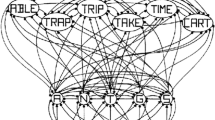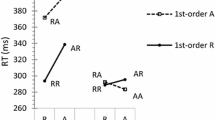Abstract
The magnitude of the semantic priming effect is known to increase as the proportion of related prime–target pairs in an experiment increases. This relatedness proportion (RP) effect was studied in a lexical decision task at a short prime–target stimulus onset asynchrony (240 ms), which is widely assumed to preclude strategic prospective usage of the prime. The analysis of the reaction time (RT) distribution suggested that the observed RP effect reflected a modulation of a retrospective semantic matching process. The pattern of the RP effect on the RT distribution found here is contrasted to that reported in De Wit and Kinoshita’s (2014) semantic categorization study, and it is concluded that the RP effect is driven by different underlying mechanisms in lexical decision and semantic categorization.


Similar content being viewed by others
Notes
It is relevant to note that the variation in nonword ratio that accompanies the manipulation of RP is less extreme (assuming an equal number of word and nonword trials). For example, the RP of .75 versus .25 corresponds to the nonword ratio of .80 versus .57, and the RP of .25 versus .50 corresponds to the nonword ratio of .57 versus .67. This may explain why an RP effect has not been found consistently in lexical decision with short SOAs (see Hutchison, 2007, Table 1).
Another related measure is a vincentile, which is the average of each RT bin. Quantile plots and vincentile plots are generally very similar.
It should be pointed out that in contrast to this pattern, at the longer SOAs and with clearly presented targets, Balota et al. (2008) found that the semantic priming manipulation consistently produced a shift in the RT distribution. This pattern will be discussed in more detail in the Discussion section.
Balota et al. (2008) have made a similar point that lexical decision may involve both “the influence of the prime” and “the word recognition processes that drive lexical decisions for the target in the unrelated condition” (p. 507). However, their suggestion was that there is a “race” between these sources of information; in contrast, our view, as elaborated below, is that they are combined to form a “compound cue.”
References
Antos, S. J. (1979). Processing facilitation in a lexical decision task. Journal of Experimental Psychology, 5, 527–545.
Balota, D. A., & Yap, M. J. (2011). Moving beyond the mean in studies of mental chronometry: The power of response time distributional analyses. Current Directions in Psychological Science, 20, 160–166.
Balota, D. A., Yap, M. J., Cortese, M. J., Hutchison, K. A., Kessler, B., Loftis, B., ... Treiman, R. (2007). The English Lexicon Project. Behavior Research Methods, 39, 445–459.
Balota, D. A., Yap, M. J., Cortese, M. J., & Watson, J. M. (2008). Beyond mean response latency: Response time distributional analysis of semantic priming. Journal of Memory and Language, 59, 495–523.
Becker, C. A. (1980). Semantic context effects in visual word recognition: An analysis of semantic strategies. Memory & Cognition, 8, 493–512.
Blazely, A. M., Coltheart, M., & Casey, B. J. (2005). Semantic impairment with and without surface dyslexia: Implications for models of reading. Cognitive Neuropsychology, 22, 695–717.
Bormann, T., & Weiller, C. (2012). “Are there lexicons”? A study of lexical and semantic processing in word-meaning deafness suggests “yes”. Cortex, 48, 294–307.
Brysbaert, M., & New, B. (2009). Moving beyond Kuçera and Francis: A critical evaluation of current word frequency norms and the introduction of a new and improved word frequency measure for American English. Behavior Research Methods, 41, 977–990. doi:10.3758/brm.41.4.977
Cousineau, D., Brown, S., & Heathcote, A. (2004). Fitting distributions using maximum likelihood: Methods and packages. Behavior Research Methods, Instruments, & Computers, 36, 742–756.
Davis, C. J. (2010). The spatial coding model of visual word identification. Psychological Review, 117, 713–758.
De Groot, A. M. B. (1984). Primed lexical decision: Combined effects of the proportion of related prime-target pairs and the stimulus-onset asynchrony of prime and target. The Quarterly Journal of Experimental Psychology Section A, 36, 253–280. doi:10.1080/14640748408402158
De Wit, B., & Kinoshita, S. (2014). Relatedness proportion effects in semantic categorization: Reconsidering the automatic spreading activation process. Journal of Experimental Psychology: Learning, Memory, and Cognition. doi:10.1037/xlm0000004
Forster, K. I., & Forster, J. C. (2003). DMDX: A windows display program with millisecond accuracy. Behavior Research Methods, Instruments and Computers, 35, 116–124.
Gomez, P., Perea, M., & Ratcliff, R. (2013). A diffusion model account of masked vs. unmasked priming: Are they qualitatively different? Journal of Experimental Psychology: Human Perception and Performance. doi:10.1037/a0032333
Grondin, R., Lupker, S. J., & McRae, K. (2009). Shared features dominate semantic richness effects for concrete concepts. Journal of Memory and Language, 60, 1019.
Heathcote, A., Popiel, S. J., & Mewhort, D. J. K. (1991). Analysis of response time distributions: An example using the Stroop task. Psychological Bulletin, 109, 340–347.
Hohle, R. H. (1965). Inferred components of reaction times as functions of foreperiod duration. Journal of Experimental Psychology, 69, 382–386.
Huber, D. E., Shiffrin, R. M., Lyle, K. B., & Ruys, K. I. (2001). Perception and preference in short-term word priming. Psychological Review, 108, 149–182.
Hutchison, K. A. (2007). Attentional control and the relatedness proportion effect in semantic priming. Journal of Experimental Psychology: Learning, Memory, and Cognition, 33, 645–662.
Hutchison, K. A., Neely, J. H., & Johnson, J. D. (2001). With great expectations, can two “wrongs” prime a “right”? Journal of Experimental Psychology: Learning, Memory, and Cognition, 27, 1451–1463.
Hutchison, K. A., Heap, S. J., Neely, J. H., & Thomas, M. A. (2014). Attentional control and asymmetric associative priming. Journal of Experimental Psychology: Learning, Memory, and Cognition, 40, 844–856. doi:10.1037/a0035781
Kahan, T. A., Neely, J. H., & Forsythe, W. (1999). Dissociated backward priming effects in lexical decision and pronunciation tasks. Psychonomic Bulletin & Review, 6, 105–110.
Landauer, T. K., McNamara, D. S., Dennis, S., & Kintsch, W. (2007). Handbook of Latent Semantic Analysis. Mahwah, NJ: Lawrence Erlbaum Associates.
McRae, K., & Boisvert, S. (1998). Automatic semantic similarity priming. Journal of Experimental Psychology: Learning, Memory, and Cognition, 24, 558–572.
McRae, K., Cree, G., Seidenberg, M., & McNorgan, C. (2005). Semantic feature production norms for a large set of living and nonliving things. Behavior Research Methods, 37, 547–559. doi:10.3758/bf03192726
Neely, J. H. (1977). Semantic priming and retrieval from lexical memory: Roles of inhibitionless spreading activation and limited-capacity attention. Journal of Experimental Psychology: General, 106, 226–254.
Neely, J. H. (1991). Semantic priming effects in visual word recognition: A selective review of current findings and theories. In D. Besner & G. W. Humphreys (Eds.), Basic processes in reading: Visual word recognition (pp. 264–336). Hillsdale, NJ: Erlbaum.
Neely, J. H., & Keefe, D. E. (1989). Semantic context effects on visual word processing: A hybrid prospective/retrospective processing theory. In G. H. Bower (Ed.), The psychology of learning and motivation: Advances in research and theory (Vol. 24, pp. 207–248). New York, NY: Academic Press.
Neely, J. H., Keefe, D. E., & Ross, K. L. (1989). Semantic priming in the lexical decision task: Roles of prospective prime-generated expectancies and retrospective semantic matching. Journal of Experimental Psychology: Learning, Memory, and Cognition, 15, 1003–1019.
Norris, D. (1984). The mispriming effect: Evidence for an orthographic check in the lexical decision task. Memory & Cognition, 12, 470–476.
Norris, D. (2006). The Bayesian Reader: Explaining word recognition as an optimal Bayesian process. Psychological Review, 113, 327–357.
Norris, D., & Kinoshita, S. (2008). Perception as evidence accumulation and Bayesian inference: Insights from masked priming. Journal of Experimental Psychology: General, 137, 434–455.
Norris, D., & Kinoshita, S. (2012). Reading through a noisy channel: Why there’s nothing special about the perception of orthography. Psychological Review, 119, 517–545.
O’Connor, R. E., & Forster, K. I. (1981). Criterion bias and search sequence bias in word recognition. Memory & Cognition, 9, 78–92.
Plaut, D. C. (1997). Structure and function in the lexical system: Insights from distributed models of word reading and lexical decision. Language and Cognitive Processes, 12, 765–805.
Posner, M. I., & Snyder, C. R. R. (1975). Attention and cognitive control. In R. L. Solso (Ed.), Information processing and cognition: The Loyala symposium (pp. 55–85). Hillsdale, NJ: Lawrence Erlbaum Associates, Inc.
Pratte, M. S., Rouder, J. N., Morey, R. D., & Feng, C. (2010). Exploring the differences in distributional properties between Stroop and Simon effects using delta plots. Attention, Perception, & Psychophysics, 72, 2013–2025.
Ratcliff, R. (1978). A theory of memory retrieval. Psychological Review, 88, 552–572.
Ratcliff, R., & McKoon, G. (1988). A retrieval theory of priming in memory. Psychological Review, 95, 385–408.
Seidenberg, M. S., Waters, G. S., Sanders, M., & Langer, P. (1984). Pre- and postlexical loci of contextual effects on word recognition. Memory & Cognition, 12, 315–328.
Smith, E. E., Shoben, E. J., & Rips, L. J. (1974). Structure and process in semantic memory: A featural model of semantic decisions. Psychological Review, 81, 214–241.
Thomas, M. A., Neely, J. H., & O’Connor, P. (2012). When word identification gets tough, retrospective processing comes to the rescue. Journal of Memory and Language, 66, 623–643.
Tweedy, J., Lapinski, R., & Schvaneveldt, R. (1977). Semantic-context effects on word recognition: Influence of varying the proportion of items presented in an appropriate context. Memory & Cognition, 5, 84–89. doi:10.3758/bf03209197
Yap, M. J., Tse, C.-S., & Balota, D. A. (2009). Individual differences in the joint effects of semantic priming and word frequency revealed by RT distributional analyses: The role of lexical integrity. Journal of Memory and Language, 61, 303–325.
Yap, M. J., Balota, D. A., & Tan, S. E. (2013). Isolating lexical and decision processes in the lexical decision task. Journal of Experimental Psychology: Learning, Memory, and Cognition, 39, 140–158.
Acknowledgments
This research was supported by the International Macquarie University Research Excellence Scholarship (2011043) awarded to Bianca de Wit. We thank the reviewers—Jim Neely and two anonymous—who provided valuable comments on an earlier version of the manuscript.
Author note
Bianca de Wit, ARC Centre of Excellence in Cognition and its Disorders (CCD) and Department of Cognitive Science, Macquarie University. Sachiko Kinoshita, ARC Centre of Excellence in Cognition and its Disorders (CCD) and Department of Psychology, Macquarie University.
Author information
Authors and Affiliations
Corresponding author
Rights and permissions
About this article
Cite this article
de Wit, B., Kinoshita, S. An RT distribution analysis of relatedness proportion effects in lexical decision and semantic categorization reveals different mechanisms. Mem Cogn 43, 99–110 (2015). https://doi.org/10.3758/s13421-014-0446-6
Published:
Issue Date:
DOI: https://doi.org/10.3758/s13421-014-0446-6




